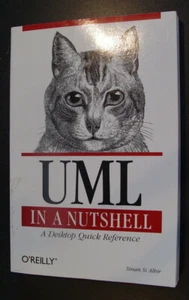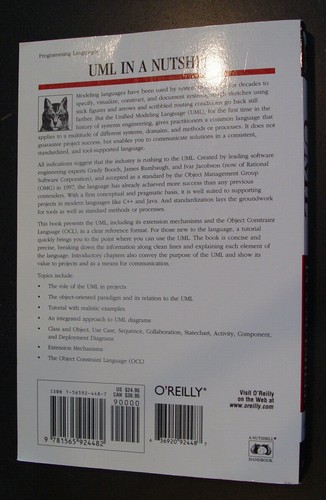Picture 1 of 2


Gallery
Picture 1 of 2


Have one to sell?
UML in a Nutshell by Sinan Si Alhir
US $6.00
ApproximatelyAU $9.24
Condition:
“Looks brand new”
Like new
A book that looks new but has been read. Cover has no visible wear, and the dust jacket (if applicable) is included for hard covers. No missing or damaged pages, no creases or tears, and no underlining/highlighting of text or writing in the margins. May be very minimal identifying marks on the inside cover. Very minimal wear and tear. See the seller’s listing for full details and description of any imperfections.
Oops! Looks like we're having trouble connecting to our server.
Refresh your browser window to try again.
Postage:
Free delivery in 2-4 days
Get it between Mon, 18 Aug and Wed, 20 Aug to 94104.
Located in: Layton, Utah, United States
Returns:
30-day returns. Seller pays for return postage.
Payments:
Shop with confidence
Seller assumes all responsibility for this listing.
eBay item number:165387734797
Item specifics
- Condition
- Like new
- Seller notes
- “Looks brand new”
- Subject
- UML
- Subject Area
- UML
- Level
- Beginner
- Educational Level
- Adult & Further Education, Elementary School, High School, Vocational School
- ISBN
- 9781565924482
About this product
Product Identifiers
Publisher
O'reilly Media, Incorporated
ISBN-10
1565924487
ISBN-13
9781565924482
eBay Product ID (ePID)
762668
Product Key Features
Number of Pages
296 Pages
Language
English
Publication Name
Uml in a Nutshell
Subject
General, Programming Languages / Uml
Publication Year
1998
Type
Textbook
Subject Area
Computers
Series
In a Nutshell (O'reilly) Ser.
Format
Trade Paperback
Dimensions
Item Height
0.8 in
Item Weight
16.5 Oz
Item Length
9 in
Item Width
6 in
Additional Product Features
Intended Audience
Scholarly & Professional
LCCN
00-500297
Dewey Edition
21
Illustrated
Yes
Dewey Decimal
005.1/17
Table Of Content
Preface Part I: Introducing the Unified Modeling Language Chapter 1-Introduction What Is the Unified Modeling Language? What Constitutes the Unified Modeling Language? The Evolution of the Unified Modeling Language Chapter 2-The Big Picture Problems, Solutions, and Problem Solving Problems and Solutions Problem Solving Chapter 3-Object Orientation Worlds Paradigms Object Orientation Objects and Classes Links and Associations Scenarios and Interactions Variations and Summary Part II: Using the Unified Modeling Language Chapter 4-A Unified Modeling Language Tutorial The Unified Modeling Language Diagrams Use Case Diagrams Class Diagrams Object Diagrams Sequence Diagrams Collaboration Diagrams Statechart Diagrams Activity Diagrams Component Diagrams Deployment Diagrams Other Notation and Information Chapter 5-The Unified Modeling Language Architecture Metamodel Architectural Views and Diagrams Mechanisms Problems, Solutions, and Problem Solving Part III: The Unified Modeling Language Quick Reference Chapter 6-Diagramming and Model Organization Diagrams Notes Packages The Role of Tools Chapter 7-Class and Object Diagrams Classes Objects Associations Links Compositions Chapter 8-Use Case Diagrams Actors Use Cases Communicates Relationships Extends Relationships Uses Relationships Chapter 9-Sequence Diagrams Interactions Class Roles Lifelines Activations Messages Chapter 10-Collaboration Diagrams Collaborations Association Roles Multi-roles Message Flows Chapter 11-Statechart Diagrams States Transitions Events Actions Chapter 12-Activity Diagrams Swimlanes Action States Action Flows Object Flows Chapter 13-Component Diagrams Components Development-Time Relationships Calls Relationships Chapter 14-Deployment Diagrams Nodes Communication Relationships Run-Time Relationships Supports Relationships Becomes Relationships Chapter 15-Extension Mechanisms Stereotypes Properties Constraints Tagged Values UML Extension for the Objectory Process for Software Engineering UML Extension for Business Modeling Chapter 16-The Object Constraint Language Expressions Object Properties Collections Standard Types References World Wide Web Resources Books Index
Synopsis
The Unified Modeling Language (UML), for the first time in the history of systems engineering, gives practitioners a common language. This concise quick reference explains how to use each component of the language, including its extension mechanisms and the Object Constraint Language (OCL), Modeling languages have been used by system developers for decades to specify, visualize, construct, and document systems; rough sketches using stick figures and arrows and scribbled routing conditions go back still further. But the Unified Modeling Language (UML), for the first time in the history of systems engineering, gives practitioners a common language that applies to a multitude of different systems, domains, and methods or processes. It does not guarantee project success, but enables you to communicate solutions in a consistent, standardized, and tool-supported language.All indications suggest that the industry is rushing to the UML. Created by leading software engineering experts Grady Booch, James Rumbaugh, and Ivar Jacobson (now of Rational Software Corporation), and accepted as a standard by the Object Management Group (OMG) in 1997, the language has already achieved more success than any previous contenders. With a firm conceptual and pragmatic basis, it is well suited to supporting projects in modern languages like C++ and Java. And standardization lays the groundwork for tools as well as standard methods or processes.This book presents the UML, including its extension mechanisms and the Object Constraint Language (OCL), in a clear reference format. For those new to the language, a tutorial quickly brings you to the point where you can use the UML. The book is concise and precise, breaking down the information along clean lines and explaining each element of the language. Introductory chapters also convey the purpose of the UML and show its value to projects and as a means for communication.Topics include: The role of the UML in projects The object-oriented paradigm and its relation to the UML Tutorial with realistic examples An integrated approach to UML diagrams Class and Object, Use Case, Sequence, Collaboration, Statechart, Activity, Component, and Deployment Diagrams Extension Mechanisms The Object Constraint Language (OCL), Modeling languages have been used by system developers for decades to specify, visualize, construct, and document systems; rough sketches using stick figures and arrows and scribbled routing conditions go back still further. But the Unified Modeling Language (UML), for the first time in the history of systems engineering, gives practitioners a common language that applies to a multitude of different systems, domains, and methods or processes. It does not guarantee project success, but enables you to communicate solutions in a consistent, standardized, and tool-supported language.All indications suggest that the industry is rushing to the UML. Created by leading software engineering experts Grady Booch, James Rumbaugh, and Ivar Jacobson (now of Rational Software Corporation), and accepted as a standard by the Object Management Group (OMG) in 1997, the language has already achieved more success than any previous contenders. With a firm conceptual and pragmatic basis, it is well suited to supporting projects in modern languages like C++ and Java. And standardization lays the groundwork for tools as well as standard methods or processes.This book presents the UML, including its extension mechanisms and the Object Constraint Language (OCL), in a clear reference format. For those new to the language, a tutorial quickly brings you to the point where you can use the UML. The book is concise and precise, breaking down the information along clean lines and explaining each element of the language. Introductory chapters also convey the purpose of the UML and show its value to projects and as a means for communication.Topics include: The role of the UML in projectsThe object-oriented paradigm and its relation to the UMLTutorial with realistic examplesAn integrated approach to UML diagramsClass and Object, Use Case, Sequence, Collaboration, Statechart, Activity, Component, and Deployment DiagramsExtension MechanismsThe Object Constraint Language (OCL)
LC Classification Number
QA76.76.D47A424 1998
Item description from the seller
Popular categories from this Store
Seller feedback (553)
- k***c (871)- Feedback left by buyer.Past monthVerified purchaseFast delivery, wonderfully packaged, arrived in perfect condition, and I could not be more pleased in every way! I HIGHLY recommend this seller!!!
- c***a (252)- Feedback left by buyer.Past 6 monthsVerified purchaseItem arrived as described with quick shipping and great packaging. Excellent transaction!ACTION COMICS #1000 (DC) | NM+ or Better | SUPERMAN | Jim Lee | FREE SHIPPING (#164958386883)
- t***z (3157)- Feedback left by buyer.Past yearVerified purchaseSmooth transaction with great communication & delivered as advertised with excellent packaging & fast shipping. Thank you!Lot of kids sunglasses. 20 Pairs for $28. Price Cannot be beat! (#164426356444)

